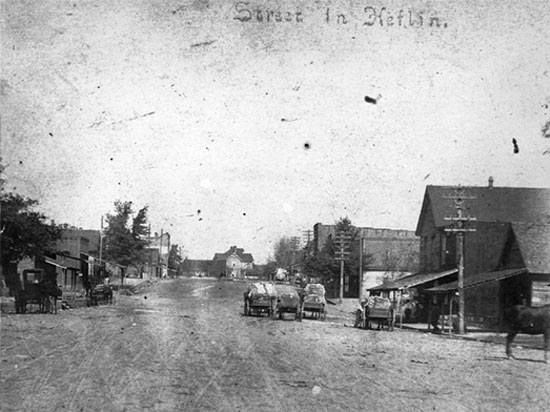Heflin was established in 1882 as a rail road station stop from Atlanta. Much of what is currently the City of Heflin was originally owned by the Ross family. The family arrived in Alabama in the early 1830’s and later donated lands for schools, churches, and a cemetery.
The name “Heflin” was in honor of Dr. Wilson L. Heflin, doctor to many in the area of Cleburne and Randolph Counties and father of Alabama U.S. Senator, J. Thomas Heflin (1920-1931).
Heflin was incorporated on December 10th, 1886. The corporate limits were reestablished in 1892. By 1891, Heflin was a bustling, trading center. A report from “The Cleburne New Era” stated, “There has been an average of a hundred wagons a day in Heflin for the past week, hauling oil, guano and other supplies. An average of 12 train car loads of lumber are shipped from this place each week.” The economy was supported for many years by cotton crops, which after being baled, was shipped by freight to various places. The huckleberry business also thrived during the late 1800s and early 1900s. The berries were packed in crates and shipped to New York, Chicago and Detroit. In 1883, a public steam gin was built and in 1885, a gristmill was added.
Most of Heflin’s early residents were merchants who opened their businesses along Ross Street and lived in homes along side streets, as the town and the population grew.
Ross Institute was established in 1885. The state granted Ross Institute a charter and the town built Ross Collegiate Institute, so named in hopes that it would someday become a college. This institute was located at the corner of Willoughby Street near the present Smalltown Bank. In 1909, The Cleburne County Board of Education sold bonds to build a new high school at the corner of Burns and Evans Streets. Ross Institute became the town’s elementary school, being Cleburne County Elementary. The dreams of the college had faded away.
Heflin was home to two hotels in 1891, the Summit House and the Edmondson Hotel. Mercantile stores began to open in 1889. In 1889, Atkins and Owens opened for business. In 1902, Wright Drug Company opened (still operating today) and in 1905, the Bank of Heflin was established. The county seat was moved to Heflin from Edwardsville in 1906. And in 1911 the “Cleburne News” was established.
The city continued to grow throughout the first part of the 20th Century. In the 1920s and 1930s two new hotels were constructed. They were the Central and the Alexander. With the completion of Highway 78 during the 1930s, street paving began and city water was available. The city water tank was located on the grounds of the current courthouse. From 1950-1980 most of the city streets were paved, sewage lines were installed, several new industries opened and the present town hall was built. Heflin has had three town hall buildings and stood on the same site located at 850 Ross Street. The present building was erected in 1953.
Heflin was a center of economic growth and industry throughout the late 70’s & 80’s with several manufacturing industries calling Heflin home.
The City currently is home to three county schools: Cleburne County High School, Cleburne County Middle School, and Cleburne County Elementary.
With the construction of Interstate 20, Heflin began to see growth at the interstate exits for commercial and Industrial Development. Heflin continues to be the center of retail and county government for Cleburne County.



